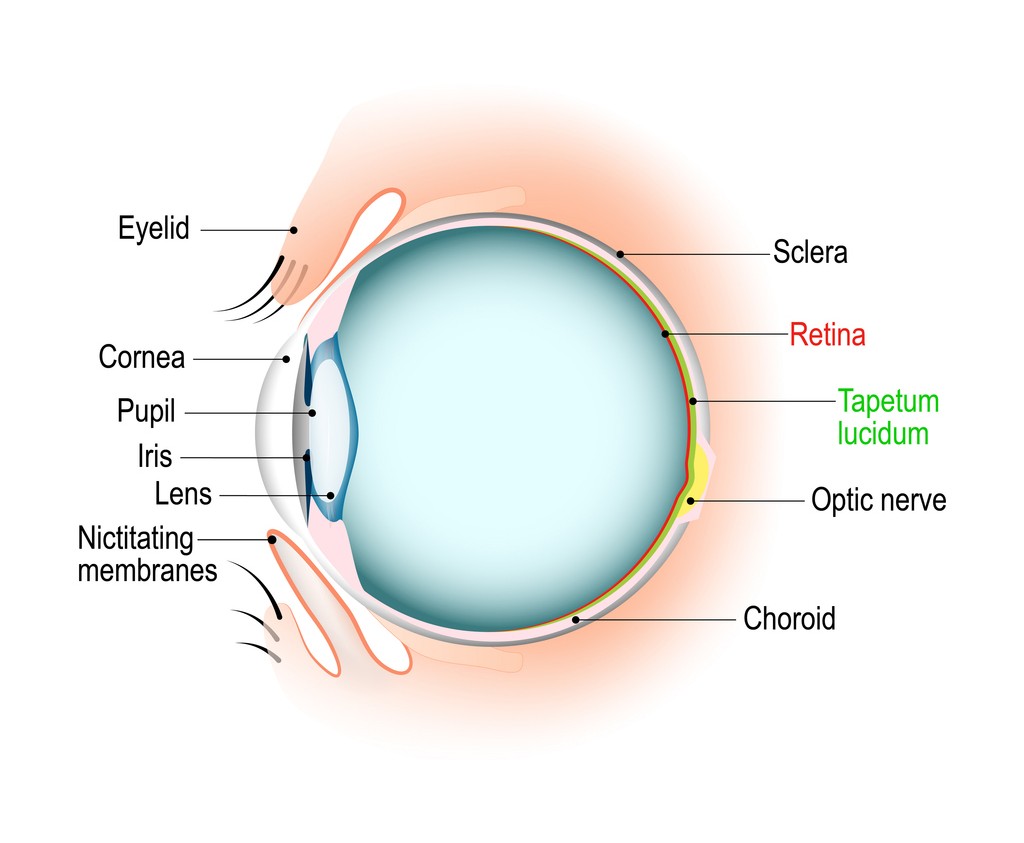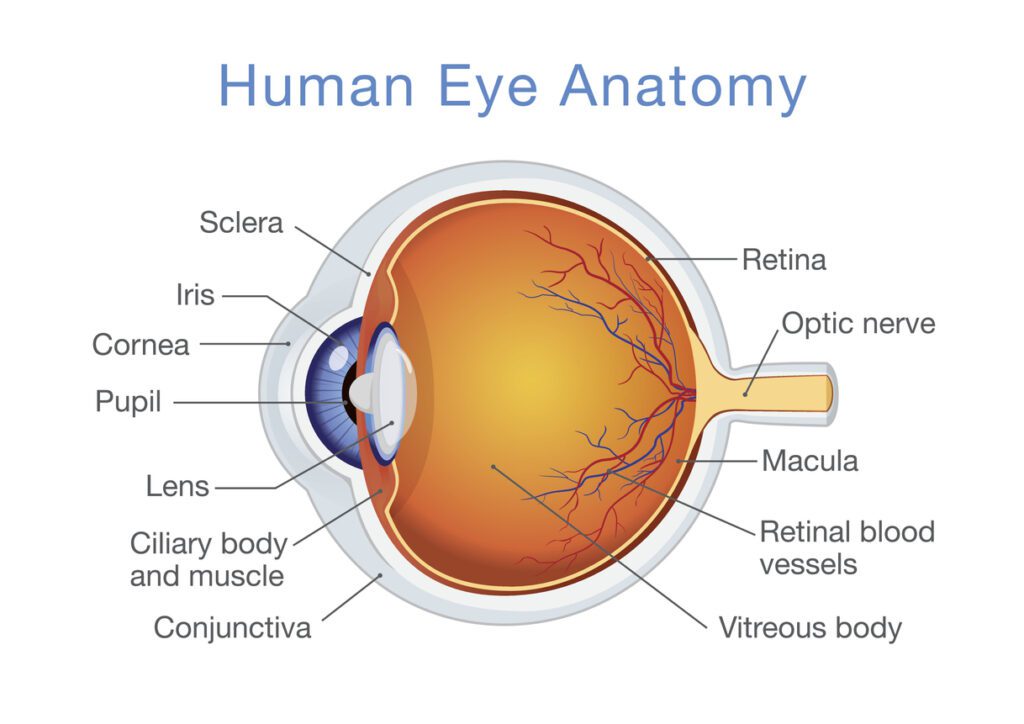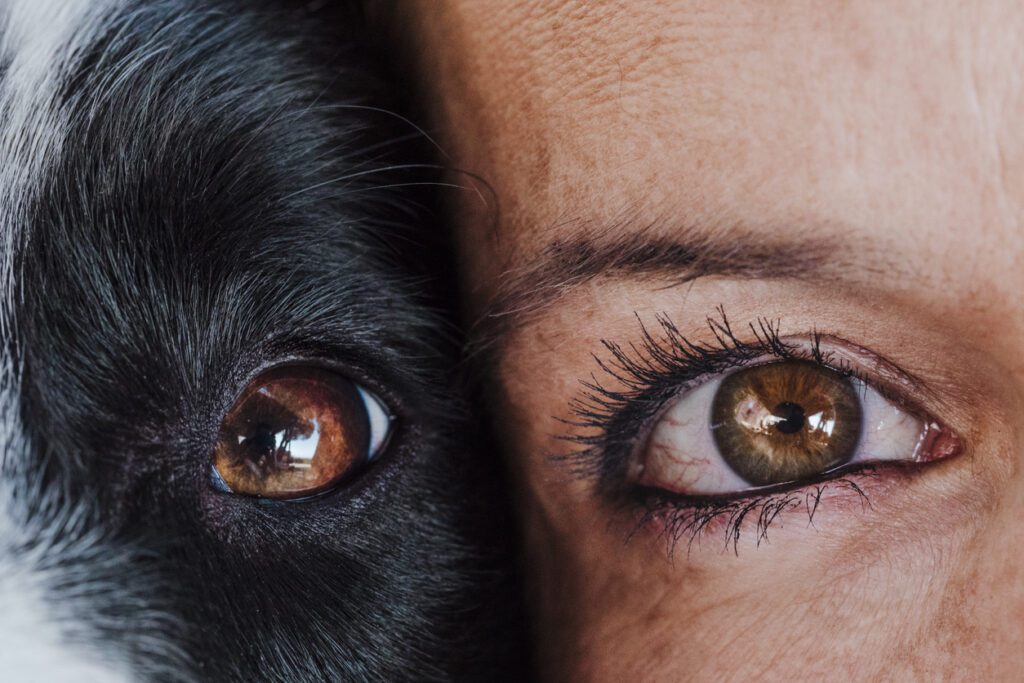Have you ever considered the unique way your dog perceives the world? When I watch Teddy or Bear, my two beloved Golden Retrievers, fixated on something—a squirrel in the yard, a ball rolling across the floor—I can’t help but feel a twinge of envy. Their perception of the world is not just different from ours; in some ways, it’s even superior. It turns out that dogs have their own vision, with unique features that set them apart from human vision.
The Structure of a Dog’s Eyes
We must look into their eyes’ structure to understand why dogs see the way they do. Like ours, a dog’s eye has key components such as the cornea, lens, retina, rods, and cones. However, it’s in the details where things get fascinating.


Human retinas are dominated by cone cells, the photoreceptors responsible for processing color. On the other hand, dogs have retinas dominated by rods, which are highly sensitive to light and motion. This difference gives dogs an incredible ability to see in low-light conditions. However, it also means their color perception isn’t as strong as ours.
Here’s an interesting comparison: Humans see a full spectrum of colors, ranging from vibrant reds to cool blues because our retinas have three types of cones. Dogs, however, only have two types of cones, allowing them to see blues and yellows but not reds or greens. While their world may look a little less colorful than ours, it’s still vivid—just not in the same hues we’re used to.
Superior Night Vision
One area where dogs truly outshine us is their night vision. Have you ever noticed how your dog’s eyes sometimes glow eerily in the dark when light hits them? This is thanks to a specialized layer in their eyes called the tapetum lucidum. This reflective layer acts like a mirror, bouncing light back onto the retina and allowing dogs to make the most of dim lighting. Their night vision is not just good; it’s exceptional, giving them a significant advantage over humans in low-light conditions.
But that’s not all. Dogs’ eyes are also packed with more rod cells than ours, making them particularly adept at detecting movement and light in the dark. Their pupils are also larger than ours, letting in even more light. While humans stumble in the dark, our canine companions can move surprisingly confidently, relying on their enhanced night vision to guide the way.
This makes perfect sense, considering that their ancestors, wolves, hunted in low-light conditions at dawn or dusk. Their sharp night vision is a legacy passed down through the generations.
Is a Dog’s Distance Vision Blurry?
Here’s where things get a little humbling for our furry friends. While dogs have outstanding night vision and motion detection, they don’t see fine details as sharply as we do. Their distance vision can be blurry. For example, what we can make out clearly from 100 feet away might be less distinct—or even fuzzy—for a dog.
That said, dogs rely heavily on their other senses, like smell and hearing, to make sense of the world, so this slight disadvantage in detail hardly seems to bother them after all; what they may lack in visual detail, they more than make up for with their incredible noses (but that’s a story for another day)!
How Dogs See the World in Motion
One area where dogs continue to outperform humans is in motion detection. Thanks to their rod-dominated retinas, they are much better at noticing fast-moving objects. If you’ve ever thrown a ball for a game of fetch and marveled at how quickly your dog reacts, now you know why. Their eyes can pick up on even the slightest motion far better than ours.
A Unique Perspective
What strikes me most about a dog’s vision is how it perfectly matches its needs. While humans rely on vibrant colors and sharp details, dogs have evolved to master the art of survival—spotting movement, navigating at night, and detecting subtle shifts in their surroundings. Their eyesight isn’t just different; it’s beautifully tailored to their world, showcasing their adaptability and resourcefulness. As dog parents, we can’t help but be impressed and respectful of this unique perspective of a dog’s vision.
Learning about Teddy and Bear’s vision has deepened my connection with them. It makes me think twice when we’re walking, and they stop to stare at something unseen in the distance. Are they noticing a movement I missed? Are they capturing a detail I’ve been too busy to spot? I’ll never know, but it’s a reminder to slow down and occasionally see the world through Teddy and Bear’s eyes. This reflection and empathy towards our pets’ unique vision is something that we, as dog owners, can all benefit from.

Dogs vs. Humans: A Quick Comparison
Here’s a summary of how dogs’ vision stacks up against ours:
- Colors: Humans perceive a full-color spectrum (thanks to three types of cones), while dogs primarily see blues and yellows with less distinction in reds and greens.
- Night Vision: Dogs triumph in this area with tapetum lucidum, rod-dominant retinas, and larger pupils, which give them a significant edge in low-light conditions.
- Detail and Distance: Humans are better at seeing fine details and distant objects clearly, while dogs’ distance vision can be blurry.
- Motion Detection: Dogs are far better at spotting fast-moving objects, thanks to their rod-rich retinas.
The Marvel of Canine Vision
It’s easy to see why dog owners, animal lovers, and pet enthusiasts find canine vision fascinating. It’s not just about how dogs look at the world but what their vision says about them—that they are creatures perfectly tuned to their environment, with senses designed to keep them safe, curious, and engaged.
Next time you’re with your furry friend, take a moment to appreciate the uniqueness of their perspective. While they may not see the vivid reds of a sunset, their ability to spot that squirrel in the shadows is genuinely remarkable. Share your observations and experiences about your dog’s vision in the comments below. Dogs have so much to teach us, not just about love and loyalty but about appreciating the beauty in things we often overlook. After all, when we look into their eyes, we’re reminded that there’s more than one way to see the world, and that’s truly inspiring.
References:
Belmont Eye Center. How Is Dogs Eye Vision Different Than Humans? https://belmonteyecenter.com/how-is-dogs-eye-vision-different-then-humans/
Can Dogs See Better in the Dark Than Humans?https://www.google.com/search?q=why+do+dogs+see+better+in+the+dark+then+humans.+what+is+the+reason+their+eyes+become+reflective+in+the+dark&oq=&gs_lcrp=EgZjaHJvbWUqCQgBECMYJxjqAjIJCAAQIxgnGOoCMgkIARAjGCcY6gIyCQgCECMYJxjqAjIJCAMQIxgnGOoCMgkIBBAjGCcY6gIyCQgFECMYJxjqAjIJCAYQIxgnGOoCMgkIBxAjGCcY6gLSAQk5NzM5ajBqMTWoAgiwAgHxBRBegzvIqS9k&sourceid=chrome&ie=UTF-8
Thank you for reading this blog post. If you have any questions or comments, please leave them in the Comments section below.
Copyright © 2019. I Don’t Know All The Answers, Nikki Mastro.
All of my photographs and documents are Copyrighted.
The main image and several other photos included in this blog post are from the iStock.com library.
No part of this website, including text, photographs, and documents, may be reproduced, stored in a retrieval system, or transmitted in any form or by any means without written permission from the copyright holder. All unauthorized use is strictly prohibited. If you choose to copy or share any information from my site, you must provide a link to the source. I appreciate your cooperation.
For further information concerning “I Don’t Know All The Answers.”
– Website and Blog: https://www.idontknowalltheanswers.com
– Facebook: https://www.facebook.com/Nikki.L.Mastro/
– Instagram: https://www.instagram.com/i_dont_know_all_the_answers/
– Linkedin: https://www.linkedin.com/in/nikki-mastro-05455a3a/
– Youtube Channel: https://www.youtube.com/@idontknowalltheanswers1954

